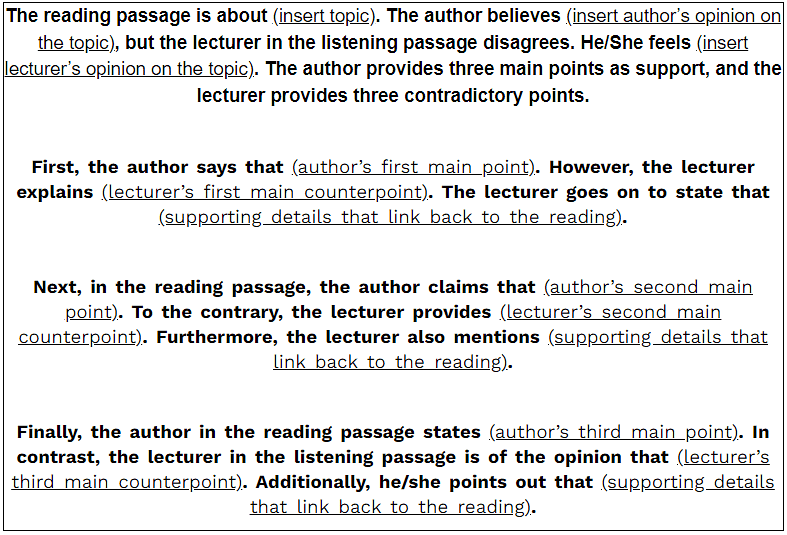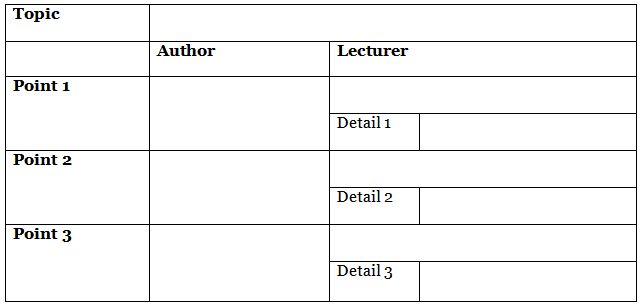Techniques to Ace Integrated Writing Task | Writing for TOEFL PDF Download

1. Understand What the Integrated Writing Task Is
- The initial stage of this assignment involves engaging in a reading task. Within a given time frame of three minutes, you will be required to read a passage that spans approximately 250 to 300 words. The passage will focus on a specific academic subject and subsequently present three key points that offer further elaboration or supporting details regarding the topic. It is of utmost importance that you are capable of recognizing and restating both the subject matter and the author's three primary points within your essay.
- Subsequently, we proceed to the more challenging segment, which involves listening comprehension. Following the allocated three minutes for reading the passage and taking notes, you will listen to a lecture lasting approximately two minutes. The lecture will invariably revolve around the same academic subject as the author discussed. Moreover, the lecturer will present three primary points regarding the topic, which typically contradict or challenge the ideas expressed by the author in the preceding passage you have read. The counterarguments put forth by the lecturer will correspond to the order of the author's three main points. Generally, the lecturer will elaborate on the reasons behind the author's flawed theories or present alternative evidence that refutes the author's perspectives on the given topic. In your essay, it is crucial that you can accurately identify and rephrase the lecturer's three main points, as well as elucidate how they contradict or invalidate the author's principal arguments.
- Lastly, the reading passage will be presented once again (without the repetition of the listening audio), and you will have the remaining 20 minutes to outline, write, and revise your Integrated Writing essay response. The TOEFL suggests writing within the range of 200-225 words, but it is advisable to exceed this count. A well-constructed integrated essay typically falls between 250-300 words.
The essay prompt will require you to summarize the key points articulated in the lecture. This implies that the majority of your answer should focus on the lecturer's remarks in response to the author. The task will never ask for your personal opinion on the topic, so refrain from expressing your own thoughts. Avoid initiating a sentence with phrases such as "I believe that" or "In my opinion" within the integrated essay; instead, reserve such expressions for the Independent Writing task.
2. Take Excellent Short-hand Notes
As mentioned previously, your essay should primarily concentrate on summarizing the points (including counterpoints) presented by the lecturer. Therefore, it is crucial to take meticulous notes while listening to the lecture. Keep in mind that you will only have one opportunity to listen to the lecture; there is no option to rewind or pause it. However, there is no need to panic. You are not expected to recall every single word spoken by the lecturer. This task does not assess your memory skills. Rather, you are expected to comprehend and remember the main ideas conveyed in the lecture. Consequently, taking effective notes becomes essential. Additionally, maintaining focus is of utmost importance during the listening process to extract the key points. Practicing with sample materials before the TOEFL exam can help you enhance your listening skills.
- Given that the lecturer will present counterarguments to the author's claims, it is advisable to start by taking notes on the reading passage even before listening to the lecture. While reading, jot down the topic of the passage (which will be the same as the lecture) and the author's three main points in the correct order. Remember that the topic can be found in the introduction paragraph, while each main point is outlined in the respective body paragraphs. It is crucial to maintain the order, as the lecturer's main counterpoints will follow the same sequence as the author's main points.
- During the lecture, make sure to note down the lecturer's main counterpoints. Additionally, try to include 1-2 supporting details provided by the lecturer for each of the main counterpoints. These details can enhance your writing score. Below is a sample note-taking template that you can utilize on the day of the test:

- During the note-taking process, it is important to avoid writing in complete sentences. Instead, focus on capturing key words and employ shorthand or symbols. For instance, rather than spelling out lengthy words, abbreviate them to a few letters, such as using "info" for "information" or "tech" for "technology." Additionally, utilize symbols to represent certain words or concepts, such as using "->" to denote a cause, "<->" for contrast, or "^" to signify an increase.
- The shorthand and symbols you use should be meaningful to you. It is essential to practice your note-taking skills while reading or listening to academic passages, allowing you to develop your own personalized method of shorthand note-taking. By doing so, you can enhance your efficiency in capturing relevant information during the TOEFL exam.
3. Use a Template
- The TOEFL test evaluators anticipate a specific structure for your Integrated Writing response. Therefore, it is advisable to enter the TOEFL exam with a clear understanding of how you will structure your Integrated Writing essay. It is recommended to organize your essay with a minimum of four paragraphs: an introduction and three body paragraphs.
- In the introduction, aim to write three or four concise sentences. Begin with a statement that indicates the topic from both the reading passage and the lecture. Subsequently, present the author's stance on the topic as presented in the reading passage. Next, explain the contrasting viewpoint of the lecturer on the topic. Conclude the introduction by stating that both the author and lecturer have three main points to support their respective positions.
- The following three body paragraphs should adhere to a consistent structure, with each paragraph spanning three or four sentences. In each body paragraph, devote one sentence to the author's main point. Then, dedicate two to three sentences to the lecturer's primary counterpoint, ensuring to provide supporting details for the lecturer's stance. Each body paragraph should address one of the three main points outlined in the reading passage and the lecture.
- Technically, a conclusion paragraph is not mandatory in the Integrated Writing task. However, many TOEFL experts recommend including a brief conclusion of one to two sentences, summarizing the contrasting positions of the author and lecturer. While it is rare to find an academic essay without a conclusion, the TOEFL test aims to assess your academic writing skills. Therefore, if time permits (after proofreading your essay), you may choose to include a succinct conclusion.
Furthermore, you can save valuable time by prepping certain parts of your essay in advance, employing a template. To ensure the uniqueness of your essay, it is recommended to develop your own personalized template. However, provided below is an example template that can serve as a model as you create your own structure:
4. Don’t Copy the Reading Passage
The structure of your Integrated Writing essay should mirror that of the reading passage, consisting of four paragraphs: an introduction and three body paragraphs. It is crucial to avoid a common mistake made by students in the Integrated Writing task, which involves excessive reliance on the reading passage. While the reading passage will reappear for reference after the lecture, it is important not to duplicate its content. Remember that the task requires you to summarize the points made by the lecturer. Therefore, limit your discussion of the author's main point to just one sentence in each paragraph.
Furthermore, it is essential to avoid plagiarism when discussing the author's position. Instead of directly copying from the reading passage, strive to paraphrase the author's points in your essay. Keep in mind that the evaluators are interested in assessing your English writing abilities, not your ability to replicate content. Therefore, it is crucial to refrain from copying the reading passage verbatim.
5. Confidently Use Complex Grammar and Vocabulary
- This is a language test, so even if you don’t know anything about the topic of the Integrated Writing task, don’t worry. What is important is how well you write your essay. So, show the examiners that your level of English is good by using complex grammatical structures and vocabulary. Also use connectors and transitional phrases to give your essay a nice flow from one point to another.
- While using complex grammar and vocabulary is important, it is wasted if used incorrectly. Everyone has different areas in their English grammar that they struggle with, so make sure you practice essays before the TOEFL exam to see where you most often make mistakes. Then, on test day, only use grammatical structures that you are confident are correct.
- The same is true for vocabulary. Don’t use words you don’t confidently know the meaning of or how to spell. Remember the TOEFL exam does not have a spell check function, so you are graded on your ability to spell as well. If you are not sure about the meaning of or how to spell a certain word, don’t use it. Think of another word or synonym that you can use and spell correctly.
6. Save Time to Proofread
It is essential for every writer to engage in the editing process. Despite your confidence in using grammar and vocabulary, the time constraints of writing your essay, coupled with the absence of a spell-check feature, can result in errors. Therefore, it is crucial to allocate 1-2 minutes at the end to carefully proofread your essay. By doing so, you can rectify any avoidable spelling or grammatical mistakes and potentially salvage points that would otherwise be deducted. Taking a few extra moments to review your work can make a significant difference.7. Practice, Practice & Practice
- You are allotted 20 minutes to organize your essay, adhere to a template, employ diverse grammatical structures, utilize an extensive vocabulary, avoid direct copying from the reading passage, and allocate time for proofreading. While this may seem overwhelming at present, the most effective remedy is to engage in ample practice beforehand. Prior to taking the TOEFL exam, there are numerous practice Integrated Writing tasks available that you can complete.
- In addition to writing practice essays, it is crucial to review your work afterwards and identify areas for improvement. By revising and reflecting upon your performance, you can make significant strides in enhancing your skills. Actively analyzing your essays will prove invaluable in your journey toward improvement.
|
31 videos|29 docs
|

|
Explore Courses for TOEFL exam
|

|


















